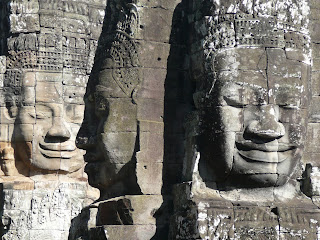
An apsara at Angkor Wat
When I was seven, a family of Cambodian refugees came to live with my family. A special arrangement had been made with a few key businesses that made it possible for refugees to relocate, and my parents felt a responsibility, as people of conscience and opponents of the wars in Vietnam and Cambodia, to assist in any way they could. For about a year the Chau family lived with us and did their best to adapt and adjust to life in Northern Utah.
Since that time, I've been intrigued by Khmer culture, the splendors of Angkor architecture, and the horrors of the Khmer Rouge regime. Just as the Vietnam War left an indelible mark on my parents' generation, I've grown up feeling affected, confused, and moved by Cambodia. It was high time to visit.
Z and I made our way to Siem Reap after a wonderful week in Luang Prabang, Laos, and met up with her parents (both linguists) who were visiting for an academic conference. Below are some images from our time in both Siem Reap and Phnom Phen as well as some thoughts on our time there.
Buddha engulfed by a tree at Ta Prohm
Shadow puppetry retelling of an episode from the Ramayana
Dancing apsara at Angkor Wat

Vendor with wares outside our bus
Traditional ciclo (pedal rickshaw)
Typical transportation just miles outside Siem Reap
Mixed Buddhist-Hindu imagery at Angkor Wat
Massive benevolent heads at Bayon
Intense sales pressure
Kompong Phluk village on the mighty Tonle Sap Lake
Leading up to our time in Cambodia I kept thinking I´d be clever and title a blog post ¨Holiday in Cambodia.¨Right up until we arrived in Phnom Phen I thought that´d be clever. Then we visited The genocide museum at Tuol Sleng and even the slightest poke at humor or punk-rock cleverness seemed offensive.
Tuol Sleng is really the high school that was turned into Pol Pot´s secret prison named ¨S-21¨, the site where tens of thousands of Cambodians were tortured and killed. It´s a haunting, fascinating, but ultimately disturbing monument to a time that must not be forgotten. One wing is a series of bare rooms with a bed and a photograph showing the violence that took place there. Another series of rooms hold meticulously documented--and beautifully shot--photographs of both victims and their torturers. T
More than once I was sickened as I recognized images from old ¨power violence¨ records, but the experience of visiting such a visceral place is important. Remembering and memorializing this time is important. Facing this history--really one group´s political, social, and economic effort to erase history and start again--needs to be done.

Leading up to our time in Cambodia I kept thinking I´d be clever and title a blog post ¨Holiday in Cambodia.¨Right up until we arrived in Phnom Phen I thought that´d be clever. Then we visited The genocide museum at Tuol Sleng and even the slightest poke at humor or punk-rock cleverness seemed offensive.
Tuol Sleng is really the high school that was turned into Pol Pot´s secret prison named ¨S-21¨, the site where tens of thousands of Cambodians were tortured and killed. It´s a haunting, fascinating, but ultimately disturbing monument to a time that must not be forgotten. One wing is a series of bare rooms with a bed and a photograph showing the violence that took place there. Another series of rooms hold meticulously documented--and beautifully shot--photographs of both victims and their torturers. T
More than once I was sickened as I recognized images from old ¨power violence¨ records, but the experience of visiting such a visceral place is important. Remembering and memorializing this time is important. Facing this history--really one group´s political, social, and economic effort to erase history and start again--needs to be done.

Art exhibit mixing archival images and the reflection of enlarged photos as well as the viewer in the same space


Eery hallways between holding cells
Young comrades who carried out the torture at Tuol Sleng
Online resources:
Timeline of the Khmer Rouge, the genocide, and information on the tribunal
Cambodian Genocide Program at Yale
Documenting ¨Year Zero¨ (POV interview)
Kaing Guek Eav, aka ¨Duch¨, on trial (from the Guardian online)
Books worth reading:
First They Killed My Father
Brother Number One
Children of the River
Online resources:
Timeline of the Khmer Rouge, the genocide, and information on the tribunal
Cambodian Genocide Program at Yale
Documenting ¨Year Zero¨ (POV interview)
Kaing Guek Eav, aka ¨Duch¨, on trial (from the Guardian online)
Books worth reading:
First They Killed My Father
Brother Number One
Children of the River















No comments:
Post a Comment